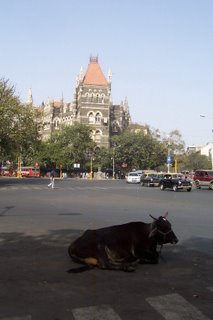
Mumbai's Victoria Train Station: vestiges of British India
While I lay awake in the white city - bollywood overnight express bus, bouncing painfully off the walls of its claustrophobic sleeping capsules, I mentally cursed that slippery little tout who convinced us its superior suspension was worth the extra money. Somehow, I managed to make it through the night and found myself staring out the window at dawn hanging over the city of Mumbai.
I remember once while travelling to Orchha, stepping off our bus in search of a toilet, an old crone pointed me to the back of a concrete roadside restaurant where I saw a thin aging man disappear behind a crack in the crumbling wall. I followed behind him and quite suddenly emerged into the light to find a large open field full of reeking garbage, families of wild boars feasting on rotting rice, and several squatting men, women, and children straining their bare bottoms in the heat. It looked like the apocalypse. It was as though in the last few hours, sometime after we got on the bus at Kajuraho and got off the bus at this nameless highway restaurant, some sort of great cataclysm had occurred which reduced civilization to defecating in their own trash.
Arriving in Mumbai, was exactly the opposite experience. The contrast between north and south India, old and new India, poor and rich India, never felt so vivid. Rajasthan's desert streets and potholes were replaced with modern highways and lane markings. It was as though, sometime between getting on the bus at Udaipur and getting off the bus at this nameless city bus stop, civilization had miraculously reconstructed itself and I found myself once again staring down a long clean avenue full of trendy coffee shops all trying to out-Starbucks each other.

Mumbai looked so clean and modern that I decided it was safe enough to try their medical facilities. The fact is, my bowels, which were waging a long and ultimately unsuccessful war against North Indian gastronomy, had begun to make alarming gargling noises that sounded to us like its last throes. Surrender was imminent and it was time to seek medical reinforcement. After I described my symptoms and had a brief checkup, the doctor asked me if I had eaten a hamburger in the last few days.
"Yes," I admitted before hastily adding, "but only out of curiosity and I couldn't finish the whole thing !"
"mmm hmmmm," the doctor replied and slowly, wisely, nodded his head: this, apparently, explained everything. He informed me I would continue to have more bowel movements then set me up with some antibiotics and the usual remedies for a serious case of the runs. Drinking regularly from my dense solution of electrolyte water, I lethargically set out to explore Mumbai: the first in our trilogy of colonial-era cities.

Renowned for their abysmal map reading ability and tenable grasp of the English language, Mumbai cabbies are among the world's cheekiest. Despite whatever nonsense they tell you, it isn't that far, their taxi meter works just fine, and your hotel did not burn down recently.
In 1661, a small inconsequential region inhabited by fishing folk, called "Bombay" by the Portuguese, was given freely to the British royal family by Portugal as part of a marriage dowry sealing the fate of India and sentencing them to a future of tea times, driving on the wrong side of the road, and soporific cricket matches. Bombay was leased to the British East India Company for the paltry annual rent of only 10 UK pounds a year. Queen Elizabeth I granted a charter to this company effectively giving them a monopoly on British trade with India. In fact, for nearly 250 years this private commercial trading company, and not the British government as is commonly believed, 'ruled' British India specifically for the purpose of making profit from iron and coal mining, as well as tea, coffee, and cotton plantations. Bombay flourished into the principle port for trade with British India complete with impressive cathedrals, steam engines, and a cosmopolitan business and culinary culture. Bombay also became a major player in the independence movement where Mahatma Ghandi launched his Quit India campaign in 1942 urging the British to leave India immediately. Bombay has recently been renamed "Mumbai" by its nationalist Hindu government referring to an earlier pre-colonial name.

Every Saturday, Mumbai's young and old, gather at Maidan park which transforms itself into a garage league cricket battle ground hosting more than twenty simultaneous matches at a time.

Bombay laundry.
Today, with a population of 16.4 million, Mumbai is a surging out of control mass of humanity haphazardly blending all of India's extremes. The touristy Colaba district is a pleasant mix of gorgeous colonial buildings, Indian open air markets, and relatively orderly streets crowded with signature black and yellow cabs. A walk down to Chowpatty beach reveals an attractive place to watch the sunset against the city's modern skyscrapers. Nevertheless, this New India often feels like a thin veneer belying the fact that over fifty five percent of its residence live in slums. Just a few blocks away from the tourist safe havens, we stumbled into sizable shanty towns that contrasted jarringly with the pristine gourmet multi-cultural dining experiences just a stone's throw away. In fact, Mumbai's Dharavi slum is the largest in Asia and is by itself home to more than one million of the world's poorest. Something in between Hollywood and Glasgow, Hindu and Islam, Britain and India, swish bars and poverty, Mumbai is, after all, a memorable and inspirational place containing all the beauty and the ugliness of the human condition.

|
















